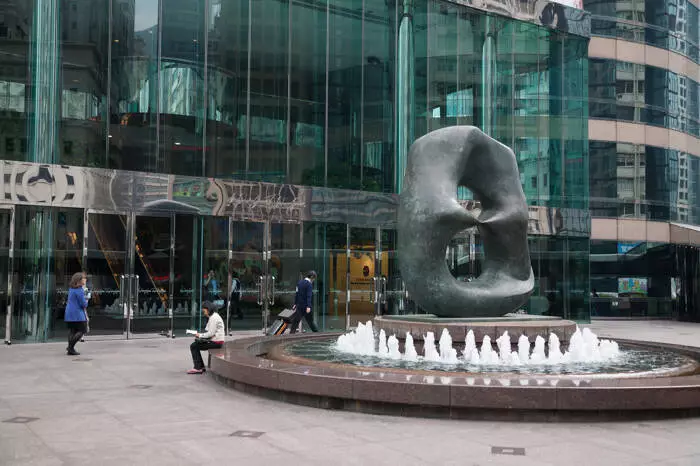The Hang Seng Index is currently experiencing a significant downturn that has persisted for five consecutive weeks, with a staggering decline of 8.47%. This unsettling trend underscores the sensitivity of the Hong Kong equity market to external pressures, particularly deteriorating trade relations that have sparked a wave of pessimism among investors. The appetite for stocks listed in both Hong Kong and mainland markets has waned severely, with technology and automotive sectors enduring the brunt of this market disarray.
The Hang Seng Technology Index, an important gauge for tech-related equities, has plummeted by 7.77%. Companies that were once the darlings of the market, such as Alibaba and Baidu, have seen their shares nosedive by 16.6% and 9.91%, respectively. This decline isn’t merely a technical adjustment; it reflects deep-seated fears about future profitability and regulatory headwinds. The grim outlook for the electric vehicle (EV) market, once a beacon of hope for sectors that were thriving in the wake of the pandemic, is particularly striking. Companies like Li Auto and NIO Inc. have witnessed drops of 7.54% and 9.39%, respectively, as rising U.S. tariffs simmer in the backdrop, exacerbating the uncertainty.
Mainland Markets Show Resilience
Conversely, the mainland Chinese markets have exhibited comparatively modest losses, with the CSI 300 and Shanghai Composite Index dipping by just 2.87% and 3.11%. This suggests a level of resilience that is often overlooked in the broader narrative of market panic. Analysts like Brian Tycangco from Stansberry Research have pointed to Beijing’s relatively restrained tariff strategy, which stands in stark contrast to U.S. regulations. This strategic restraint may serve as a potential avenue for renewed negotiations, highlighting that despite market anxieties, opportunities for progress still exist.
The balance of hope and anxiety is precariously shifting; many investors are closely monitoring Beijing’s forthcoming stimulus initiatives, believing these measures could thwart a more severe downturn. The interplay between fiscal policy and international relations will be critical as stakeholders assess future trajectories.
Safe Haven Assets Shine Amidst Chaos
In this tumultuous environment, gold has ascended to new heights, reaching a phenomenal record price of $3,245 before moderating to close the week at $3,238—a remarkable increase of 6.61%. The growing demand for safe-haven assets amid a turbulent economic backdrop has illuminated a crucial trend: when risk becomes pronounced, investors often gravitate towards gold. The sell-off in the U.S. bond market coupled with declining dollar values has further fueled this trend, solidifying gold’s status as a refuge during times of uncertainty.
While the commodities market is witnessing upheavals, it is essential to highlight that the energy sector is likewise facing challenges. WTI crude oil prices fell by 1.84% to settle at $60.78, while iron ore also took a hit, dropping 5.36%. The collective response to these price movements reflects a growing concern about global demand, stirring questions about economic recovery in the wake of heightened trade tensions.
The Australian Market: A Flicker of Hope
In Australia, the ASX 200’s slight drop of 0.28% during the week ending April 11 reveals a market grappling with its own set of challenges. The rebound from a low of 7,160 to close at 7,647 highlights the indomitable spirit of the market, aided by Trump’s unexpected tariff maneuvers. Although this dash of optimism curbed potential losses, it also illuminates the fragile fabric of this recovery, particularly in the mining and energy sectors.
Prominent players like BHP and Rio Tinto are not immune to the headwinds of the marketplace, experiencing losses of 3.80% and 3.03%, respectively. However, juxtaposed against this backdrop, the tech sector has emerged as a surprising beacon of strength. The S&P/ASX All Technology Index surged by 4.89%, aligning with the ascendancy of the Nasdaq, while Northern Star Resources saw a staggering increase of 13.53%, fueled by heightened demand for gold.
Navigating the Uncertainty Ahead
Amid these turbulent market conditions, it becomes increasingly essential for investors to keep a vigilant eye on geopolitical and economic developments. As central banks and governments unveil their policy maneuvers, critical metrics such as China’s GDP, U.S. retail sales, and Federal Reserve communications deserve heightened scrutiny. The evolving landscape calls for strategic foresight, as adept traders must remain agile to navigate the choppy waters of a dynamic global economy. The nuances of market sentiment, shaped by factors beyond mere economic indicators, will play a pivotal role in determining the future landscape of the Hang Seng Index and, by extension, the broader markets.

